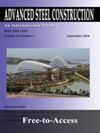STABILITY STUDY ON SCAFFOLDS WITH INCLINED SURFACES AND EXTENDED JACK BASES IN CONSTRUCTION
IF 1.7
3区 工程技术
Q3 CONSTRUCTION & BUILDING TECHNOLOGY
引用次数: 1
Abstract
A scaffolding system is a temporary structure that is commonly adopted on construction sites. As steel scaffolds are modular members manufactured with fixed dimensions, the total height of a scaffolding system seldom fits the headroom of a building when scaffolds are set up in multiple stories. This results in a difference in elevation, i.e. gap, between the top of the scaffolding system and the ceiling slab. In addition, scaffold configurations may need to be adjusted if the interior of a building has inclined planes on the ceiling slab or stairs on the ground. This study shows that the gap between the scaffold and the ceiling slab can be eliminated by altering the lengths of adjustable base jacks or adjustable U-head jacks. When the ceiling slab is inclined, it is suggested that a combined system of scaffolds with wooden shores of different lengths should be installed in the out-of-plane direction of the scaffold unit. This system can also be used when the ceiling slab is inclined and the ground has a difference in elevation (e.g., stairs) in a building. By using the second-order elastic analysis with semi- rigid joints, the load-bearing capacity and failure model are found to be very close to those obtained in the loading tests using various scaffold configurations. In the loading tests for reused scaffolds, the lower bound of the load-bearing capacity of the scaffolding systems can be obtained by applying a subsequent load on the scaffolding systems, which are commonly adopted on the construction sites. The strength reduction factor ( ) of these scaffolding systems installed by reused scaffolds can be obtained by calculating the mean value and standard deviation, which can serve as a reference for the strength design of scaffolding systems with different safety requirements. the stability behavior of various scaffolding systems, an inclined ceiling slab, adjustable U-head jacks, base jacks lengths, an difference on the ground second-order semi-rigid斜面延伸千斤顶脚手架施工稳定性研究
脚手架系统是建筑工地普遍采用的一种临时结构。由于钢脚手架是固定尺寸的模块化构件,在多层搭建脚手架时,脚手架系统的总高度往往不能满足建筑物的净空。这导致了高度的差异,即脚手架系统顶部和天花板之间的间隙。此外,如果建筑物内部在天花板板或地面楼梯上有斜面,则可能需要调整脚手架的配置。本研究表明,可以通过改变可调底座千斤顶或可调u头千斤顶的长度来消除脚手架与天花板之间的间隙。当顶板倾斜时,建议在脚手架单元的面外方向安装不同长度木岸的脚手架组合体系。该系统也可用于当建筑物的天花板板是倾斜的,地面有不同的高度时(例如楼梯)。通过对半刚性节点进行二阶弹性分析,发现其承载能力和破坏模型与不同支架结构的加载试验结果非常接近。在重复使用脚手架的加载试验中,通过对脚手架系统施加后续荷载,可以获得脚手架系统承载能力的下界,这是施工现场常用的脚手架系统。通过计算其均值和标准差,可以得到这些再利用脚手架安装的脚手架体系的强度折减系数(),可为不同安全要求的脚手架体系的强度设计提供参考。各种脚手架体系的稳定性能,有倾斜顶板,可调u头千斤顶,底座千斤顶长度,对地面有二阶半刚性差异
本文章由计算机程序翻译,如有差异,请以英文原文为准。
求助全文
约1分钟内获得全文
求助全文
来源期刊

Advanced Steel Construction
CONSTRUCTION & BUILDING TECHNOLOGY-ENGINEERING, CIVIL
CiteScore
2.60
自引率
29.40%
发文量
0
审稿时长
6 months
期刊介绍:
The International Journal of Advanced Steel Construction provides a platform for the publication and rapid dissemination of original and up-to-date research and technological developments in steel construction, design and analysis. Scope of research papers published in this journal includes but is not limited to theoretical and experimental research on elements, assemblages, systems, material, design philosophy and codification, standards, fabrication, projects of innovative nature and computer techniques. The journal is specifically tailored to channel the exchange of technological know-how between researchers and practitioners. Contributions from all aspects related to the recent developments of advanced steel construction are welcome.
 求助内容:
求助内容: 应助结果提醒方式:
应助结果提醒方式:


